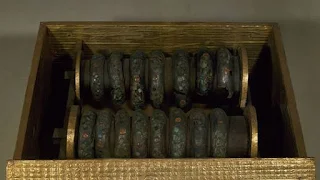Bracelets found in the tomb of Egyptian Queen Hetepheres I, mother of Khufu, the pharaoh who ordered the construction of the Great Pyramid, have revealed information about the trade networks that connected ancient Egypt with Greece.
After analyzing samples taken from the jewelry, an international team of archaeologists revealed that the bracelets contained copper, gold and lead.
A statement stated that there are inlays made of precious stones such as turquoise, lapis lazuli and agate, which were common features in ancient Egyptian jewelry.
However, the pieces, including one depicting a butterfly, also contain traces of silver, although there are no known local sources of the precious metal in ancient Egypt in 2600 BC, when jewelry was manufactured.
The team looked at the ratio of isotopes - atoms with different numbers of neutrons than usual in their nuclei - in lead. Based on this analysis, the scientists suggested that the materials were "consistent with ores from the Cyclades," a group of Greek islands in the Aegean Sea, as well as those from Lavrion, a town in southern Greece, according to a study published in the June issue of the Journal . of Archaeological Science: Reports .
“The origin of silver used in artifacts during the third millennium has remained a mystery until now,” lead author Karen Sawada, Lecturer in the Department of History and Archeology at Macquarie University in Sydney, said in the release. “This new discovery demonstrates, for the first time, the possible geographic extent of the trade networks that used it.” Ancient Egypt during the heyday of the pyramid building era.
Scientists suggested that the silver came through the port of Byblos in Lebanon now, and they are the ones who indicated that the tombs of Byblos, which date back to the end of the fourth millennium, contain many pieces of silver and that there was activity between this port and Egypt at that time. They added that the silver on the bracelets is the first evidence of long-distance trade between Egypt and Greece.
The study also provides insight into how the bracelets are formed. Study co-author Damien Gore, a professor in the Faculty of Natural Sciences at A University, explained in the statement: “The bracelets were made by forging cold-forged metal with repeated annealing (a heating process) to prevent breakage. It is also possible that the bracelets were alloyed with gold to improve appearance and ability to form during manufacturing.
It is noteworthy that Queen Hetepheres was one of the most influential queens of ancient Egypt. She was the wife of Sneferu, the first pharaoh of the Fourth Dynasty (2575 BC to 2465 BC). Scientists mentioned in the study that her tomb, which was discovered in Giza in 1925, contained many treasures such as gilded furniture, gold utensils, and jewelry, including 20 of these bracelets.
Some of the bracelets are now part of the collection at the Museum of Fine Arts in Boston.
Tags:
science



